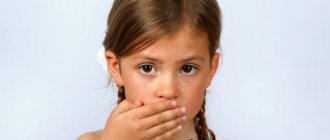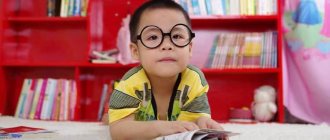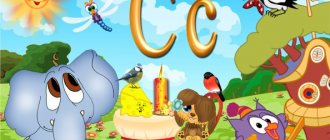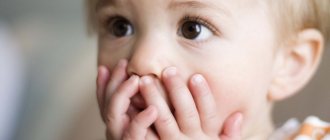Many parents think that their child’s speech develops chaotically, but this is far from the case. Children of different nationalities master their native language in the same sequence. The development of a child’s speech occurs through communication with people around him, primarily with his parents. From birth, the baby recognizes and distinguishes speech from other sounds that it hears, almost immediately beginning to recognize the mother’s voice. By screaming and crying, the baby notifies its parents about its condition (hunger, pain) and attracts the attention of adults.
At about three months, the baby begins to make drawn-out, vowel-like sounds in response to the adult’s spoken speech (booms). From three to six months, the child repeats the same sounds over and over again, looks closely at the adult’s face, squeals, laughs, and tries to imitate movements with his mouth. From six to nine months he pronounces the sounds “mmm”, “sss”, syllables similar to “ma”, “ba”, “la” (babble). From nine to twelve months, the baby imitates chains of double syllables: “ma-ma”, “da-da”, “pa-pa”, imitates coughing and clicking.
During the first year, the baby’s ability to understand the speech of others actively develops. By six months, children respond to their name, by eight months they understand the words of an adult: “come into my arms,” at nine to ten months they already follow simple instructions “give it to me,” and from nine to twelve months they recognize the names of familiar objects. Adults help the child remember the names of objects that interest him, pronouncing their names loudly and clearly and talking about their purpose. Experts call this method of communication between parents and child the naming ritual.
A one-year-old child actively uses gestures to communicate with others. In a dialogue between a child and an adult, they mean: “look at ...”, “tell me about ...”, “give me ...”, “let me look at (touch, play with) ...”. If parents look in the indicated direction, name the object or hold it out, the baby is satisfied. When a child begins to say words reflecting the concepts “here,” “give,” “this,” he continues to use pointing gestures for some time. However, speech gradually becomes the main method of communication and replaces gestures.
Kids understand much more than they say.
According to research, from the beginning of the second year of life, every month a child begins to understand about 20 new words, while on average he begins to pronounce about nine.
Experts have identified a number of features of children's initial vocabulary. Usually parents wait for the child to say the words “mom” and “dad”. But many children, even before them, had already uttered several words that parents “do not consider” words, for example, “am - am” - I want to eat; “ay” - give, etc. Toddlers begin to talk about what they want, see and feel, rather than what they know or think. Therefore, the first words indicate the most important and interesting objects, objects and actions for the baby:
- people surrounding the child (mother, father, grandmother, grandfather, uncle, aunt);
- actions performed by the baby or other people (knock - knock, top - top, am - am);
- animals and birds (meow, ki, kitty; av - av, ava; mu; igo - go, ko - k o; kar - kar);
- food (ako - milk, ana - banana, adya - water, tai - tea);
- parts of the face and body (nose, mouth, eyes);
- baby’s toys and things in the house (bear, ball, pacifier, ale - telephone);
- clothes and shoes (socks, pants, hat);
- transport (bi - bi - car, y - y - plane);
- words that reflect human states and certain qualities (I want, oh, ah, bo - bo).
Most first words are sound complexes consisting of one or two, often identical syllables (“mu”, “meow”, “av-av”, “pi-pi”, “da-da”). Experts call such sound complexes “the language of nannies” or “the language of babies.” Often the first words of babies are difficult to recognize, so many parents, when talking about their child, say that he speaks “his own language.” Some babies pronounce only the first or stressed syllable of a word. For example, the word “drink” is transformed into “pi”, and “milk” into “ako”.
Other children “change” words beyond recognition. The word transformed by the child can have the same number of syllables as the original and retain the location of the stress. But at the same time it is absolutely not similar to the original word, for example: nanAna - medicine; tititI - bricks. Most often, children distort words with confluences of sounds in which two or more consonant sounds follow one after another, for example, as in the word “hello,” which the child pronounces as “dyatite.” In words that are “difficult” in sound composition, the child swaps sounds and syllables, skips syllables, shortening words. Such sound distortions can persist in the speech of children up to 5-6 years old.
At about one and a half years old, the progressive development of the baby’s speech begins. From one and a half to two years, a child’s active vocabulary can increase to 25, and in some children up to 90 words. The number of words spoken by a child is an individual indicator of speech development, which depends on various reasons - the “speech” activity of parents and others, the health and cognitive development of the child himself.
The child’s language abilities are constantly improving in communication with people around him. The baby begins to express his needs or convey current events using words and sentences. For example, he can say “ball” - thus expressing a request for help to get the ball, “bang!” instead of “the ball fell”, “av - av” instead of “the dog is walking”.
But gradually the baby’s statements and requests become more varied, and his sentences become longer. At the end of the second - beginning of the third year of life, sentences consisting of two words appear in children's speech. Some two-and-a-half-year-old children may produce utterances consisting of five words.
The first two-word sentences consist mainly of nouns and verbs or adjectives. Children construct these sentences, ignoring the laws of grammar of their native language, omitting prepositions, conjunctions, distorting the endings of verbs, which are an indicator of the number or tense of the verb. Because of this feature of children's speech, researchers have dubbed it "telegraphic" speech. The child's first phrases, like telegrams, contain only the most essential words. For example, a child who wants to drink, instead of the long appeal “Mom, give me a drink,” will use a more capacious: “Give me a drink.”
"Telegraphic offers" usually convey:
- A request to perform some action, which contains the name of an object that interests the child. Most often this is the name of food or an interesting toy. Requests can be expressed in the affirmative form: “Give me juice,” “Give me yum-yum” (candy) or in the form of a question: “De op?” (“Where is the ball?”), “De ako?” (“Where is the milk?”).
- A request for information, which is expressed as a question and reflects the child’s desire to receive a detailed commentary on an event currently taking place or additional information about a subject or object that interests him (“Where is the woman (truncated grandmother)?”, “Is the dog big?”).
By the age of 3, a child’s vocabulary reaches approximately a thousand words. Now the baby speaks not only about objects, current phenomena and events that he observes, but also about what is not directly in front of his eyes. For example, a child can talk to mom about dad who went to work, or remember the car he saw on the street.
Kids recognize and name pictures in books. More complex sentences appear in their speech, consisting of two or more simple sentences: “I think I’ll eat”, “Look, it’s a cat.” Children with well-developed speech begin to speak in complex sentences: “when I’m big, I’ll lift you up.”
Understanding the laws of their native language, children experiment, learn to combine words with each other, use conjunctions in sentences - and, but, when, because. The child begins to use words that indicate the position of objects in relation to the speaker (here, there, here), the spatial position of the object (on the table, in the closet, under the sofa), the number of objects (one ball - many balls). The baby begins to learn the grammatical rules of the language. Having made a mistake, the child can correct himself: “She...he doesn’t want to go for a walk.”
The desire to understand the relationship between objects and phenomena in the surrounding world forces a child to ask adults about what interests him. At first, the baby’s questions are affirmative constructions, uttered with a questioning intonation: “Daddy’s tie?”, “Mommy’s jacket?” Then the “real” questions appear, which begin with the words “what?”, “where?”. And only later do questions arise that begin with the words: “why?”, “when?”, “how?”.
The child needs to learn not only to ask, but also to answer questions from adults.
Sometimes children can answer questions that begin with the words “When?”, “How?”, “Why?”, “Why?”, as if the words “who?” were used in the wording of the question. or “where?” For example, to the question “Have you already walked?”, a child may answer: “In the yard,” and to the question “Why did you take this?” say: "This is a banana." However, by the age of three to three and a half years, most children begin to answer questions correctly.
A child, like a sponge, absorbs an adult’s verbal assessments and judgments, which often become his own. Now parents have to watch their own words. The phrase carelessly uttered by the mother: “something the porridge didn’t turn out to be very tasty today” can lead to the child refusing to eat it after the first spoon, justifying his refusal with the words: “The porridge is not tasty.”
A three-year-old child begins to take into account in his behavior an adult’s verbal commentary on his statements or actions, and understands prohibition or praise. He tells others about what he feels, thinks, experiences, and can express his attitude towards people - love, affection, displeasure. The child begins to realize the power of words to influence others. He discovers that words can control people's behavior by asking another person to do what the child needs. By accompanying their actions with verbal comments, children learn to manage their own behavior. A kid who is building a tower can address himself with the following words: “No need for cubes, the tower will fall apart.”
The pronunciation side of speech also develops: by the age of 3, many children correctly and clearly pronounce many sounds: vowels - a, u, i, o, consonants - m, p, b, t, d, n, v, f, k, g, x, although the speech of babies is not always understandable to others. The most characteristic feature of pronunciation at this age is softness - the child pronounces “masinya” - instead of “machine”, “lyozetka” - instead of “spoon”, “neska” - instead of “leg”. Often the child replaces “difficult” sounds to pronounce with “easier” ones. Errors and replacements in pronouncing sounds are very diverse. Physiological (passing, characteristic of all young children) distortions (incorrect pronunciation and substitutions) of sounds at this age are:
- the absence in speech of the hissing sounds Ш, Ж, Ш, Ш or their replacement with other sounds - “losyadka” - instead of “horse”, “kosetka” - instead of “kitty”;
- absence of the sound “R” (“kaova” - instead of “cow”, “ot” - instead of “mouth”), or replacement of the sound “R” with the sounds “L”, “L”, “V”, “Y” (“ lac” - instead of “cancer”, “lyamaska” - instead of “daisy”, “vak” - instead of “cancer”, “yyba” - instead of “fish”);
- violation of the pronunciation of the sound “L” - softening it (“sausage” - instead of “sausage”), replacing the sound “L” with the sound “Y” (“tui” - instead of “chair);
- replacing the sounds “K” and “G” with the sounds “T” and “D” (“taplya” - instead of “drop”, “dus” - instead of “goose”);
- replacing voiced sounds with unvoiced ones ("cod" - instead of "bunny").
The pronunciation of children of primary preschool age depends on the structure of words - the child pronounces the same sound in words of different “complexity” differently. The more complex the structure of the word, the greater the likelihood that the child will distort the pronounced sound (for example, “yogurt” instead of yogurt). In “light” words, where this sound is combined with vowels, he will pronounce it correctly (“fox”, “Sonya”). Children still have difficulty pronouncing 2-3 adjacent consonant sounds.
If one of the sounds in such a combination is not “mastered” enough by the child, it is either skipped or pronounced distorted. In addition to skipping “difficult” sounds, the child can shorten long, unfamiliar words, skipping one or more syllables, - “ampitura” - instead of “temperature”, “kavotka” - instead of “frying pan”, swap sounds or syllables, - “pyselos” - instead of “vacuum cleaner”, “hairman” - instead of “suitcase”.
The voice apparatus of a child in his third year of life is also not yet strong enough. Children often speak quietly, or, conversely, very loudly; they do not know how to whisper. The speech exhalation is also still very short - its length is enough to pronounce a short phrase. Nevertheless, most children are good at repeating various intonations after adults and correctly using them in their speech. All of the listed child speech disorders belong to the so-called physiological speech disorders, which are a normal age-related stage of speech development.
However, some children may experience abnormal speech formation and delayed speech development. In this case, you need to contact a specialist - a speech therapist (a teacher who corrects speech disorders) to get recommendations and, if necessary, begin immediate treatment.
general information
Normally, the baby pronounces the first word at the age of 10-11 months; a simple phrase appears at the age of one year. Due to various factors, this does not happen; the child remains silent or limits himself to onomatopoeia. This happens for various reasons.
At three years of age, a child’s speech is characterized by:
- sentences of 3-4 words;
- singular and plural are used;
- the relationship between word and object;
- simple prepositions;
- the ability to present events sequentially;
- adjectives, adverbs and pronouns appear.
Incorrect sound pronunciation (absence of hissing, whistling sounds) should not cause alarm. These groups will appear later in speech; the organs of articulation are not ready to reproduce them.
There are no delays in physical development; the baby begins to sit, stand on his feet, and walk in due time. The only thing that is noted about him is the absence of speech or the use of incomprehensible words, the so-called “bird language”. The child randomly connects sounds, comments on all actions, but no one understands him.
An example of such speech: “na gokazhi” is translated as “the car is going to race.” The baby arbitrarily uses syllables, rearranges them, distorts sounds.
In childhood, echolalia is observed, that is, the child speaks like an echo, repeating the last syllable of the word: “Ma-sha” turns into “...Sha.” All this is characteristic of delayed speech development (SDD).
Children with problems in speech development understand directed speech and point at objects, pictures, and people with a pointing gesture.
Child’s speech at 3 years old: deviations
A child has deviations from the norm if he:
- Experiences serious difficulties when retelling, that is, he cannot remember the content of a short simple text that is age appropriate, such as “Kolobok”, “Ryaba Hen”, he understands it poorly, cannot formulate a thought;
- Incorrectly pronounces more than 5-7 sounds by the age of 4 (three-year-old children are still allowed to do this);
- Uses onomatopoeia and simplified versions of words instead of full ones;
- Has a small vocabulary;
- Has difficulty pronouncing words - repeats sounds or syllables (instead of a machine - mmmashina, instead of a cartoon - mumumultik);
- Talks too fast.
The last 2 points are sometimes associated with stuttering.
Have you noticed these problems in your child? It is worth considering seeing a speech therapist. Because in this case, parents often do not have the necessary knowledge and will not be able to help the child on their own.
Reasons for violation
Experts do not have a consensus on why speech development is impaired. Conventionally, there are two groups of factors: biological and social.
The first include diseases of the father and mother, the pathological course of pregnancy, childbirth, and the first year of the baby’s life. The baby is sensitive to the environment, infectious diseases, injuries cause disruption of the brain.
Hypoxia and asphyxia are dangerous due to oxygen starvation. Lack of oxygen for a long time leads to the death of nerve cells. During childbirth, incorrect actions of the midwife will lead to injuries to the neck and head - this negatively affects the blood vessels. Insufficient blood flow to the brain negatively affects its functioning.
Poor environmental conditions have a negative impact on children. Emissions of harmful substances appear not on parents, but on their children. Therefore, after serious disasters (burning forests in the Moscow region in 2010), there has been a surge in the birth rate of children with pathologies of the nervous system.
Brain development is not fully understood. Experts pay great attention to social factors. During childhood, babies are sensitive to their environment. The lisping language of adults is unacceptable, as children easily adopt the pattern.
Lack of social contacts, limitations, and addiction to television lead to delayed speech development. The child begins to entertain himself and invents his own language. Without feedback from a parent, he will not improve it.
Separation of diagnoses
Formulation of the correct conclusion allows you to select an accurate correction route. It helps to completely cure the disease, allowing the child to go to a regular school.
A child may speak his own language due to psychiatric problems. Schizophrenia rarely starts in preschool age; more often it debuts in adolescence against the background of hormonal shocks.
Schizophrenia and autism are not the same thing. The second never flows into the first. These diseases have different symptoms, prognosis, and treatment.
It is difficult to diagnose schizophrenia in children. Within a month you should observe:
- strange fantasies, the child does not draw the line between the real and imaginary world;
- unreasonable fears;
- deterioration of everyday and social skills;
- incoherent speech;
- unmotivated aggression;
- contrasting drawings.
The diagnosis is made by a psychiatrist after long-term observation and a series of tests. With proper organization of the child’s life, attacks can be reduced and remission occurs. To do this, remove stress, be active, and maintain a daily routine.
Without timely treatment, mental retardation develops a second time. At the age of three, signs of antisocial behavior appear.
With autism, the child concentrates on the inner world. He will come up with a personal system of rules, rituals, and strictly follow it. The speech is incoherent, understandable only to him, and does not make contact. Noticeable from an early age:
- silence;
- avoiding eye contact;
- negative reaction to touch.
Over the years, the severity of the defect becomes stronger. In severe forms, the patient completely withdraws into himself, does not use speech, and does not enter into social contacts.
With dysarthria, problems arise only with the pronunciation side of speech. Children distort sounds, change them into simple phonemes, but their speech is relatively understandable to others. They use phrases, parts of speech, and can say whatever they want.
With alalia, the child does not speak or is limited to onomatopoeia. In the sensory form, it does not react to addressed speech, does not perceive it, and does not use a pointing gesture. With motor skills, he follows instructions but does not speak. Brain examinations reveal lesions in Broca's or Wernicke's areas.
When speech development is delayed, there is an immaturity of the cerebral cortex, which goes away on its own. As soon as a child goes to kindergarten, he seems to have a breakthrough and begins to actively chatter. With alalia this is impossible.
A competent diagnosis is important for building corrective work. In domestic defectology, an integrated approach has been adopted. Therefore, they use the help of medical, psychological, and speech therapy specialists.
Speech norms for children
Knowing what children should be able to do at different ages helps judge the presence or absence of pathology.
| Age | Norm for development of auditory skills |
| From 0 to 1.5 years | The child listens to the parent’s voice and reacts to intonation. Distinguishes the voices of loved ones, knows his own name. Accepts simple requests, for example, to stop doing something or to give a hand. By the age of 1.5 years, he begins to understand the names of some objects and recognizes them in pictures. |
| From 1.5 to 2 years | The child can point to a specific action in a plot drawing, for example, show who is sleeping or eating |
| From 2 to 3 years | Able to carry out requests with multiple actions, such as walking into another room and taking an apple from a cup. Understands fairy tales and stories heard |
| From 4 to 5 years | The child perceives complex sentences, as well as the meaning of various prepositions |
Speech therapy diagnostics
Speech problems are rarely visible from birth. Delays and developmental disorders become obvious by the age of three. If by this period there is no improvement, the speech is incomprehensible to others, parents need to show the child to a speech therapist.
You cannot delay your visit to a specialist. Early diagnosis and timely assistance increases the likelihood of a positive outcome and complete cure.
The speech therapist plays with the baby, shows him objects, and studies the degree of understanding of the spoken speech. The number of sounds, words in speech, and the presence of distortions in the syllable structure are recorded.
An anamnesis must be collected: illnesses of the parents, the course of pregnancy, development in the first year of life. The family situation, climate, and education model are studied.
Pictures are not used to examine three-year-old children, as it is difficult for them to perceive them. The specialist carries out diagnostics only during the game.
A consultation with a neurologist, psychiatrist, or audiologist is required. They check for organic problems and recommend treatment if necessary. Hearing problems require different types of help than speech delays.
Examination methods include electroencephalogram (EEG), MRI, and ultrasound of cerebral vessels. This will allow you to identify organic changes and circulatory difficulties. Drug treatment is prescribed to stimulate brain function.
A psychologist studies the state of higher mental functions - memory, thinking, attention. If necessary, special work is carried out to develop them.
How should parents behave if their child does not understand spoken language?
It can be very difficult for mom and dad to raise a child with a receptive disorder because the child does not pay attention to the adult's speech. Due to his unstable behavior, increased anxiety and whims for no apparent reason, it seems impossible to train him in any way to perceive the information he hears.
However, do not despair and be left alone with the problem. It is necessary to contact specialists so that they can comprehensively understand the violation and develop an effective correction method. The neuropsychologist at the La Salute clinic not only conducts diagnostics to identify the source of abnormalities, but also helps stimulate the development of children with various forms of disorders.
Correcting the problem
In case of problems with speech, the leading role in the work is given to the speech therapist. Its task is to cultivate speech activity. For this purpose, special classes are held where the speaking process is stimulated during games.
To develop the correct pronunciation of words, they start with onomatopoeia, simple words: mom, dad, give, baba, nanny, etc. The child is given a doll, then the speech therapist asks to return it: “Masha, give me.”
Verbs are introduced into speech: “catch”, “carry”, “roll”. Ball games are good for learning them. The Novikova-Ivantsova technique allows you to correct violations of the syllabic structure of a word.
Sensory integration is carried out. Interaction with different materials stimulates the nervous system. Large beans, cereals, chestnuts are poured into a basin and small toys are hidden among them. Handling small objects stimulates fine motor skills and the corresponding area of the brain.
Parental participation is required. At home, they are a model of speech for the child. They correctly name objects, pronounce words clearly, and correct the baby.
The speech therapist teaches the child to construct a simple phrase of 2-3 words, works on clear pronunciation of words, and expansion of the active vocabulary. After the consolidation stage, they move on to the following: correction of sound pronunciation, introduction of parts of speech, pronouns.
Forecast
The sooner the diagnosis is made and corrective assistance is started, the greater the chances of a complete cure. The average duration of treatment is about three years. Comprehensive support from specialists is required.
Classes with a speech therapist should be five times a week. Therefore, it is better to transfer the child to a specialized kindergarten. Parents work with their preschooler every day and follow the recommendations of specialists.
In severe cases, problems with oral speech provoke writing and reading disorders. Sometimes children with such defects have to go to a fifth-type correctional school (for people with severe speech impairments).
How to help your child
It is important to provide the baby with the conditions for development. Relatives and specialists should participate in this.
Rules for interaction between parents and children
A child with this disorder needs not only psychological and medical help, but also understanding from mom and dad. To facilitate learning, adults need to:
- Take your child for a walk regularly.
- Read light stories with pictures together.
- Conduct training sessions.
- Compose phrases from words that the child can understand. For example, replace the sentence “let’s go open the door” with the simple word “door”.
- Limit TV viewing. The baby will remember random words and phrases from advertisements and cartoons, which will complicate his learning.
- Provide the child with a sense of security and mutual understanding. Eliminate punishments for misconduct.
- Observe how the baby reacts to your speech. For example, he can: ignore a request or do something different from what was asked, better perceive information from one of the parents, carefully monitor gestures.
- Each action is accompanied by the same comment. For example, if you call your baby for a walk, repeat “let’s go for a walk” every time.
When addressing a child, you should follow these rules:
- look the baby in the face when talking;
- voice actions recently performed together, for example: “we ate” or “we went to the park”;
- speak in as short sentences as possible;
- pronounce words loudly, clearly and clearly, without distorting intonation;
- point to the named object.
Health care
If you notice symptoms of a receptive disorder, the first thing you should do is make an appointment with several specialists:
- Neurologist.
- Otolaryngologist. The doctor will confirm or rule out the presence of ear diseases.
- Speech therapist. Assess the degree of speech development and help you master the language.
- A psychiatrist who will work to prevent the development of mental disorders in a child.
During the examination, you may be redirected to other doctors, and may also be prescribed vitamins or nootropics to facilitate learning. Massages, physiotherapy, and psychological correction are also used for treatment.
Neuropsychological support
Neuropsychology helps evaluate disorders in detail. During the examination, the doctor examines systemic dynamic changes in the child’s brain. This allows for the development of an individualized treatment plan that addresses all aspects of the receptive disorder.
To be examined by an experienced specialist, visit the La Salute clinic. A neuropsychologist with 14 years of experience works here. Danilina Kamilla Kasimovna will understand your problem, draw up an individual plan for correcting the child’s condition, and help the child establish communication with peers and adults.
Speech therapy correction
The help of a speech therapist is necessary throughout the correction of the disorder. It can be carried out either individually or in a group of several children. Possible training methods:
- Tomatis - most effective when a disorder occurs in the first two stages of development of speech perception;
- ABA program – intensive study of the diagnosis, based on individual characteristics;
- Logorhythmics is a system of motor exercises in which movements are combined with the utterance of special phrases or musical accompaniment.
Classes with a speech therapist are aimed at the comprehensive development of the child, knowledge of the environment and adaptation. As a result of the correction, the following are processed:
- perception;
- memory;
- attention;
- communication skills;
- speech disorders.







